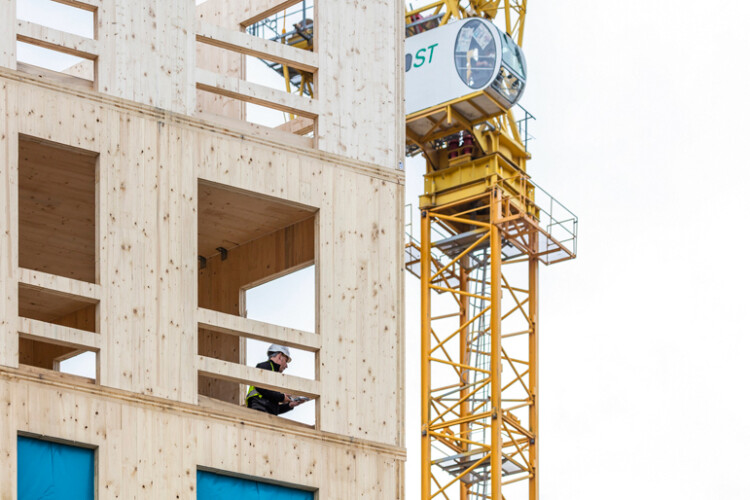It should be concerning to everyone when a mature economy with the perfect conditions for growing a wide range of tree species should be in a potentially precarious position in relation to wood supply. But that’s exactly where we find ourselves.
For decades we have failed to invest adequately in our domestic wood supply, leaving us exposed to fluctuating prices and fighting for future supplies of wood as global demand rises and our own supplies fall.
This article was first published in the The Construction Index Magazine.Sign up online
The UK is the world’s second largest importer of wood after China, importing around £7.5bn-worth of timber annually. We currently grow only around 20% of our wood requirement, leaving us exposed to a very significant balance (80%) needing to be imported from other countries.
In 2020 the UK imported 48 million cubic metres of wood products, of which 22% was sawn wood and wood-based panels destined for use by the building and construction industry. By 2021 this had increased by 15%, with the UK importing an average of one million cubic metres of timber and panel products every month – an unprecedented occurrence according to Timber Development UK, a new trade body created by the merger in 2021 of the Timber Trade Federation and the Timber Research and Development Association.
Specifically, softwood import volumes increased by over 21%, hardwoods by 26% and plywoods by over 13%, demonstrating increased demand even during ongoing Covid restrictions.
Beyond the UK, the World Bank estimates that global demand for wood products will treble in less than 30 years as the world population grows from its present 7.8 billion to 10 billion by 2050. This huge increase is being driven primarily by higher living standards, greater urbanisation – including China’s seemingly inexhaustible need for timber for both construction and manufacturing – and greater use of what is increasingly seen as a more sustainable building material.
These trends are being compounded at a time when a number of other global developments are coalescing. In particular, security of supply of natural resources is under ever greater threat from geo-political upheavals, as witnessed by the Russian invasion of Ukraine and soaring energy prices.
While the UK may not be directly affected by Vladimir Putin’s incursion into Ukraine – overall Russian timber imports into the UK are relatively small at only 1.25% – Russia remains the world’s largest supplier of timber globally.
With potentially longer-term economic sanctions placed against Russian exports, there will inevitably be significant disruption to supply chains, price hikes and pressure on countries typically supplied by Russia, Ukraine and Belarus, to seek building material imports from other sources – including those Scandinavian countries that the UK relies upon so heavily.
In addition to being the largest overall exporter of wood products, Russia is also the largest exporter of sawn timber. Although the UK only imports 6% of its sawn softwood and 7% of its plywood from Russia, the impact on the UK’s building and construction sector will be much wider, as the overall global availability of wood products will be reduced and competition likely to intensify considerably.
Even before the Russian invasion, 2021 was a year when demand for wood outstripped supply and timber prices rose significantly (with imported sawn or planed wood jumping by more than a fifth during the summer) leading to an increase in construction costs and delays in completing projects.
The National Federation of Builders called for ministers to step in and urge councils to show greater flexibility on materials changes, while the Building Back Britain Commission warned in November that the government’s housebuilding targets might be at risk.
Timber prices, for instance, are spiking because of the switch in demand towards lower-density housing over city centre apartments, with more wood needed for elements such as roof joists.
To add to potential supply chain woes, there also remains some uncertainty of supply due to Brexit. New regulations and disrupted shipments can mean materials from overseas are often delayed or challenging to source. Labour shortages have also played a part, including the lack of HGV drivers.
While the upward trend in UK and global demand for wood is clear, the UK government’s own forecasts show that supplies of home-grown wood will start to decline in the 2030s, meaning there will be less wood available in future than there is now.
This can only have a detrimental impact on the UK’s plan to become net zero by 2050. The journey towards net zero is, in part, dependent on the greater sequestration of carbon dioxide for which productive tree-planting in the UK can make a significant contribution.
For many people, tree-planting is the obvious response to global warming and there’s good reason for that. Wood is a truly sustainable resource; not only is it a readily available substitute for many materials that have much higher emissions loads – such as brick, concrete, steel and polyurethane – but the tree from which it comes sequesters large amounts of CO2 as it grows.

Wood fibre insulation, in particular, is an excellent choice for insulating homes and has impressive green credentials and there is currently interest in establishing a manufacturing plant in the UK. Recyclable, compostable and dimensionally stable, it is typically a by-product from waste wood from the sawmill industry, further adding to its sustainable credentials.
Wood is even good for the body and soul – a 2020 study by Canadian scientist Dr Graham Lowe found that wood finishings in homes and other structures can provide significant biophilic benefits – that is, they contribute to health and wellbeing.
With the UK facing the likely scenario of increased competition for future imports, it is little wonder that the Confederation of Forest Industries (Confor) is highlighting the declining supply of UK domestic wood supply and the potential risk this poses to major industries including construction and manufacturing.
The UK has ideal conditions for growing wood to build low-carbon homes and is a global leader in certifying that its forests are sustainably managed, yet while the UK government has stated its ambition to plant more trees, there has been little action on the ground outside of Scotland. Confor is now calling for much greater impetus behind those aspirations to ensure we have enough wood to help meet increasing construction demand.
The reasons why the UK’s wood supply is shrinking just when we need it to increase are complex and range from outdated perceptions of productive forestry to a disconnect between consumers’ demand for wood products and an understanding of the need to plant the forests that they come from.
It also encompasses significant hesitation on behalf of landowners to invest in long-term planting projects. Productive tree planting can deliver real financial benefits to rural economies and contribute to the UK’s net zero strategy but government support for tree-planting continues to focus just on flood prevention and the planting of native woodland solely for biodiversity.
While these are critically important activities, the importance of future supplies of wood and the opportunity to deliver a wide range of benefits in modern, well-designed, mixed woodland has largely been overlooked.
Most of the land that could be planted with trees is currently agricultural. The Committee on Climate Change, noting a reduction of around 20% in cattle and sheep numbers over the past 20 years, anticipates a further drop of about 10% by 2050 and has called on government to encourage further reductions in dairy and red meat consumption.
Much sheep farming is marginal and reliant on continued public subsidy. Confor has noted that diversifying land-use by the greater planting of trees as a crop will help more farms to become viable while helping the farming sector to contribute to net zero.
This article was first published in the The Construction Index Magazine.Sign up online
There is resistance to the widespread planting of softwood conifers from some environmental groups who campaign for native broadleaf tree planting only. This ignores the considerable biodiversity benefit that can be provided by planting mixed woodland in accordance with strict standards for forest design that have actually been developed with many of the same environmental groups.
Confor believes there is a step-change needed in attitudes towards tree planting, which, if achieved, will enable the government to meet its own targets and satisfy its ambition to use more homegrown timber in construction. Achieving this will require the government to communicate the benefits of productive woodland for building more energy-efficient low-carbon homes and carbon sequestration, as well as biodiversity and flood control, in order to combat the misconceptions that hamper productive tree-planting applications.
We also need to ensure that our existing forestry plantations are optimised. We need to better avail of planting stocks that deliver higher productivity and improved quality of fibre for downstream processing and manufacture, with further research to guarantee we are using the most productive species. Some adoption of tree-planting on shorter rotations (typically 15-19 years) could also supply manufacturers with wood for products like panel boards to fill the gap before new forests mature in 30-45 years’ time.
At the end of 2021, Confor undertook a survey to establish the level of public support for producing more home-grown wood. Over 90% of respondents were unaware that the UK imported 80% of its wood resources and 50% of respondents saw domestic wood production as being important – only just behind the importance of food production. A similar number agreed that growing more domestic timber is beneficial for the environment and a further two-thirds said that there should be forest expansion.
Being a highly populated, mature economy with a limited land mass, the UK is likely to always be a large importer of wood products. However, we are in the enviable position of having excellent growing conditions for productive planting, a robust regulatory system in place to ensure good forestry management and a deep commitment to biodiversity and achieving net zero status by mid-century.
The building blocks of a stronger domestic security of wood supply are in place. What is needed now is greater stimulus by the UK government in order to leverage these advantages into reality.
• Stuart Goodall is chief executive of Confor
This article was first published in the The Construction Index Magazine.Sign up online
Got a story? Email news@theconstructionindex.co.uk



